Casio fx-CG50 Full Review
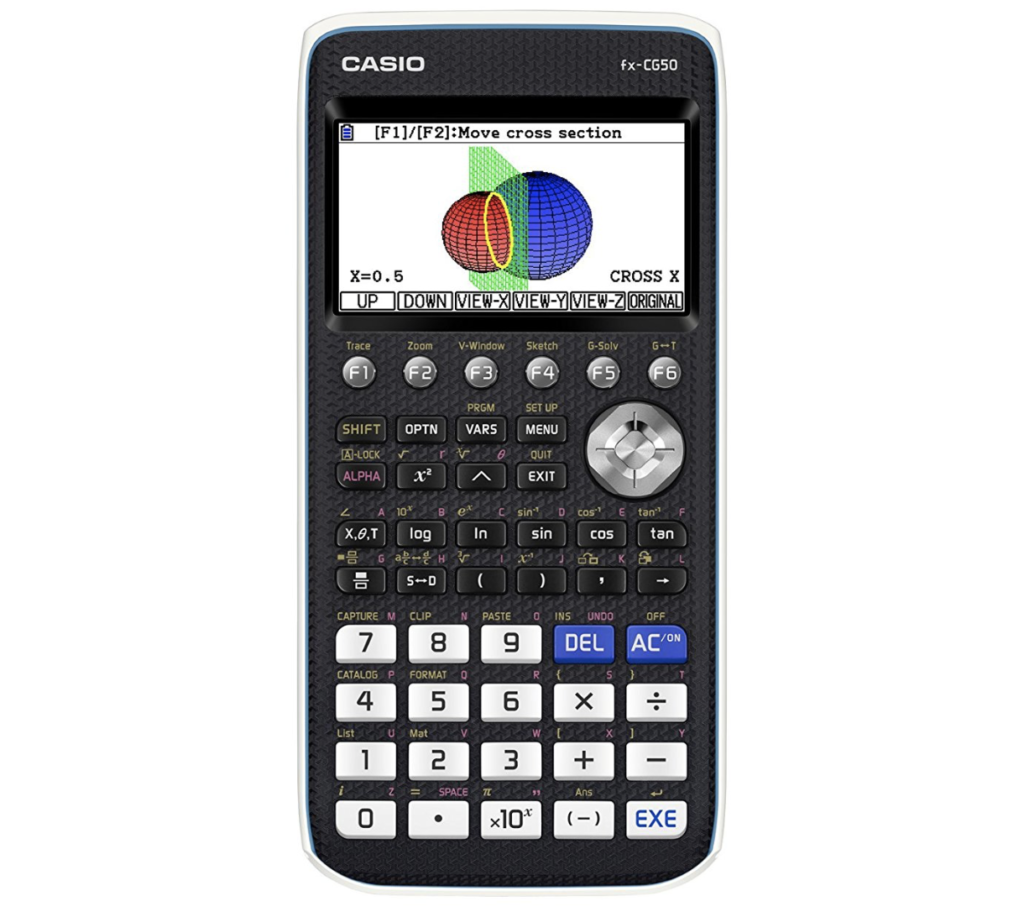
See on Amazon (commission earned)
Overview
The Casio fx-CG50 (AKA the Casio Color Graphing Calculator) is a mid level calculator from Casio that is comparable to the TI-84 Plus CE. Casio has a handful of graphing calculators that spread across a range of capabilities. The Casio fx-CG50 sits in the middle of the pack. It is superior to the Casio fx-9750GII in almost every way, except for price, but it doesn’t have many more advanced features like a CAS (computer algebra system) that you might find on one of Casios more high end models, or on something like the TI-nspire CX CAS.
The fx-CG50 is good for anyone who wants a solid calculator to put them through high school and possibly college, or for other personal use. This calculator also does not have a CAS making it available for use on more standardized tests. The fx-CG50 probably won’t blow you away, but it’s a solid calculator that shines when it comes to usability.
We think that The Casio fx-CG50 is basically a better, nicer, version of the Casio fx-9750GII. There is a pretty big price difference, but you get a nicer build, a color screen and some more advanced features.
Features and Capabilities
User Interface
The Casio fx-CG50 has a very straightforward interface that is logical and easy to use. You should have no problem picking up on it in a very short amount of time. If you have used any previous generations of the fx-CG50 or the fx-9750GII, the UI on this calculator should be very familiar.
The high resolution color screen is also a plus for usability. You are able to see more items in each menu at once and the colors make the important things and pieces of information pop.
Textbook Printing and Exact Answers
A really convenient feature on the Casio fx-CG50 is the textbook style printing of inputs and answers. What I mean by this is that the calculator will display expressions as they would be written out instead of how they would normally appear on a calculator. That means that fractions look like fractions rather than like this 2/3 and other things like exponents will actually be smaller numbers raised and to the right of their bases. This feature is becoming more and more common which is great because it makes reading and entering expressions much easier.
The fx-CG50 is also able to simplify radicals and fractions all on its own. So that means if you enter a radical, say √24, you will get the answer as 2√6 instead of a decimal. (Of corse, you can press a button to get the classic decimal answer if you ever need it)

Apps
The Casio fx-CG50 has a library of 21 apps. This is more than most calculators and each app dives fairly deep into whatever function it performs. We won’t go over all of them but we will talk about some of the most useful/significant ones.
Below is an image of all the apps in the home screen, just so you can get an idea of all of the apps this calculator includes.

The fx-CG50 has a financial calculation app that makes the calculator especially useful for things like home finance. This app has a lot of built in features and it makes doing these types of calculations pretty easy
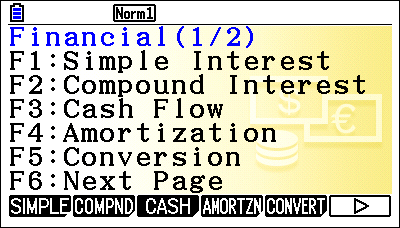
The “Physium” app will give you the full periodic table of elements as well as a good amount of scientific constants. The periodic table is one of the most impressive ones we have seen on a graphing calculator.
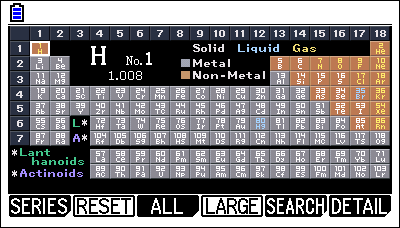
You can scroll around with the directional pad to see the atomic number and weight of each element. If you select an element and press [EXE] you will get an even more detailed description, and even a picture!
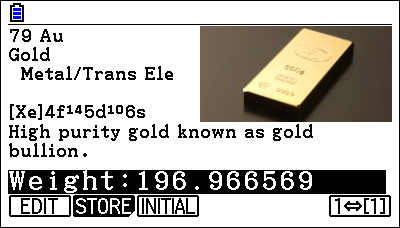
You can also select different series of the elements in the table. For example, you can see all of the Alkali Metals selected in the table below.
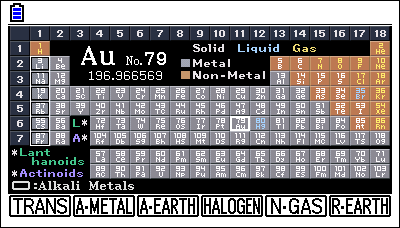
Graphing
The graphing app on the Casio fx-CG50 is great. It is simple but capable and does everything you need it to in an easy to use fashion.
Things like graphing are where calculators with color screens really shine. The fx-CG50 lets you graph up to 20 lines on the same graph
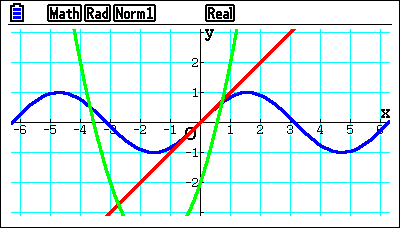
For some reason, Casio only lets you graph lines in 5 different colors, even though the screen can display many more than that. However this is made up for by the fact that you can customize the style of the line as seen below.
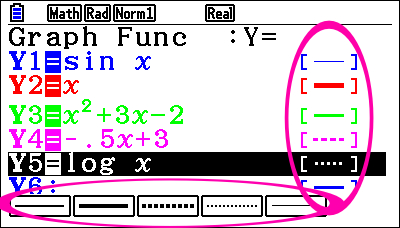
One thing to note about the Casio fx-CG50 is the speed at which it can graph lines. The fx-CG50 has a big leg up on all of the TI-84 model calculators. The lines draw very quickly. Below is the Casio fx-CG50 graphing the same lines as the TI-84 Plus CE (Texas Instruments’ newest TI-84).
As you can see the fx-CG50 wins by a landslide. These extra seconds of speed may not seem like a big deal, but it can get annoying to have to wait even just a couple seconds every time you have to graph a line. Also on a timed test like the SAT, every second is important and it can be nerve racking to watch your calculator slowly draw a line while the clock is ticking.
3D Graphing
One unique thing about the Casio fx-CG50 is its ability to graph 3D shapes. Most calculators in this price range can’t do that. Graphing 3D shapes isn’t something that you really need to do for most high school math, but later in college or in a non-standard high school math class you might find yourself using this feature.
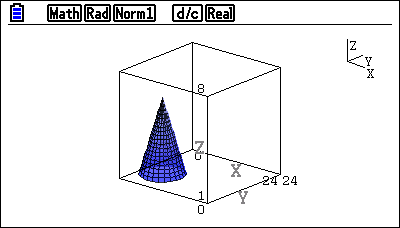
The 3D graphing app isn’t totally open though. You can choose to graph 5 different shapes a line, a plane, a sphere, a cylinder and a cone. First you select one of these shapes and then you enter the numbers into the preset equation. You can’t just graph arbitrary equations.
The graphing speed isn’t too bad but it’s not snappy either. From my tests I was able to graph a 3D shape in about 6 seconds. Once you get the shape graphed though, you can look at it from different angles no problem. Just use the directional pad and you will change your viewing angle without any hesitation by the calculator.
Hardware
Build
The Casio fx-CG50 isn’t very sleek or lightweight, but I think that it has a moderately appealing design. The color scheme and physical look of the fx-CG50 make it seem like the big brother of the Casio ClassWiz fx-991EX. Below on the left is the Casio ClassWiz fx-991EX (a scientific calculator) next to the Casio fx-CG50.
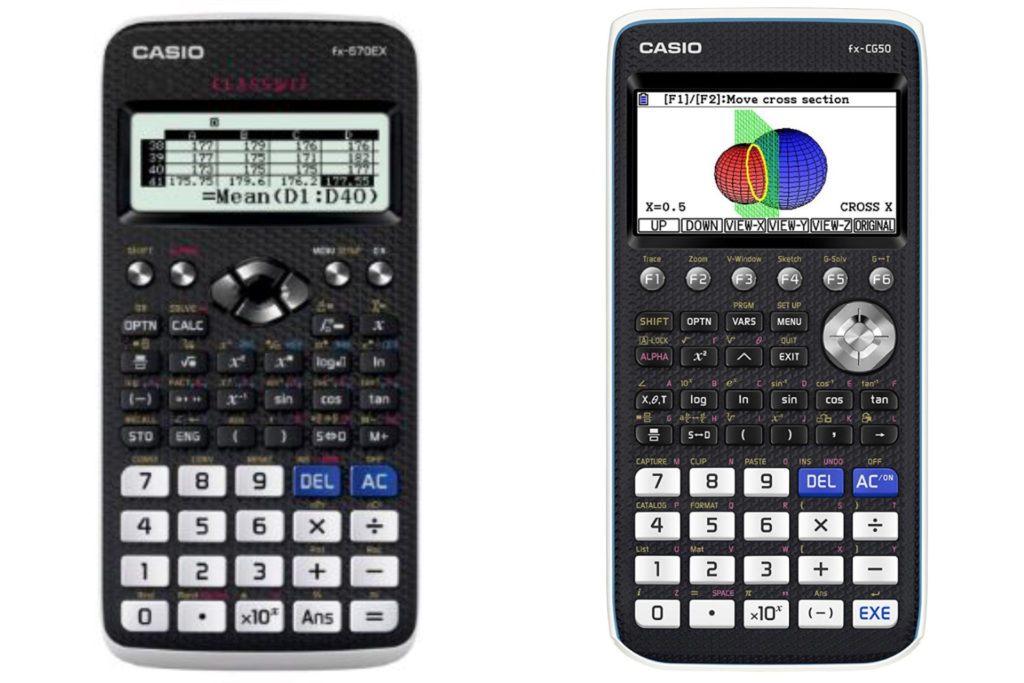
The color of the text on the buttons against the background pops out and is easy to read. The outer shell of the calculator as well as the cover is made of all white plastic. This gives you the white brick shown below that you might not have expected to get from some of the stock images of the fx-CG50. The case slides on to the back of the calculator when not in use.
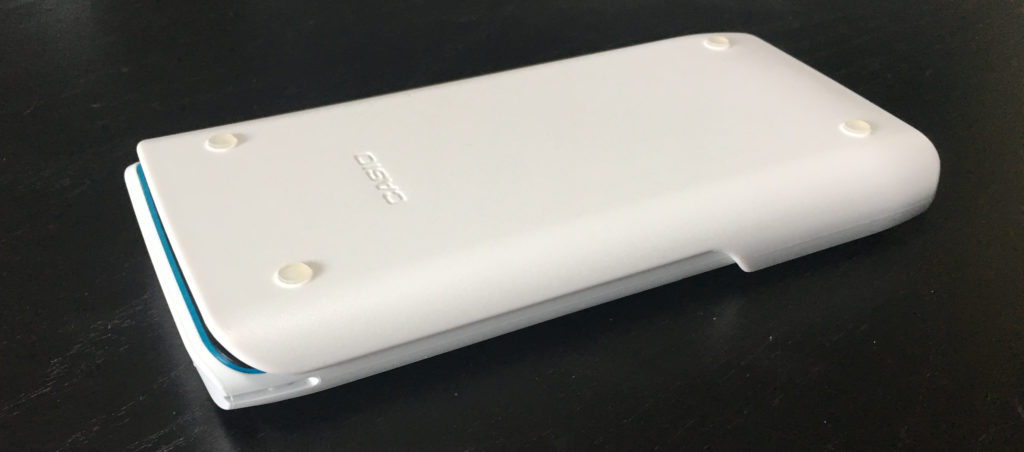
The front pannel is made of the same geometric carbon fiber looking pattern that is found on the Casio ClassWiz. This pattern gives the calculator some life and makes it a lot less boring to look at.
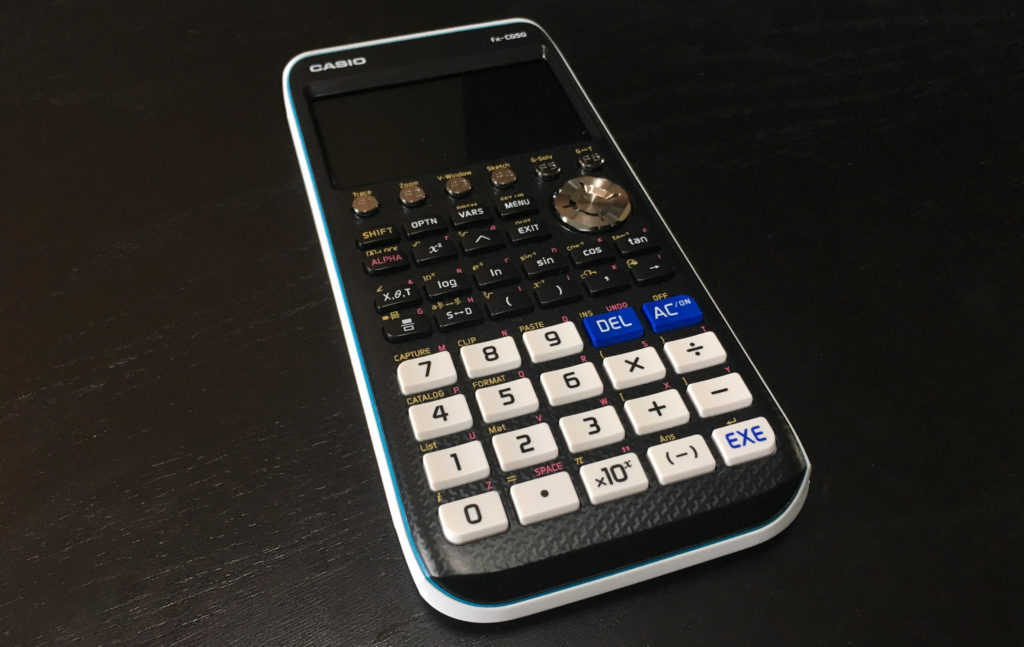
The buttons are laid out logically and will be vary fermilliar to anyone who has worked with Casio calculators in the past.
Power
The biggest disappointment when it comes to the design is the way the calculator is powered. The fx-CG50 uses 4 AAA batteries. It is a bit disappointing that we couldn’t see a rechargeable battery in this calculator especially because it came out somewhat recently, but this is one of the reasons that the price isn’t up quite as high as the TI-84 Plus.
The replaceable battery power also means that this calculator is a bit thicker and bulkier than a lot of other calculators. Below the Casio fx-CG50 (right) is shown laying next to the TI-84 plus CE (left).

Conclusion
The Casio fx-CG50 is a solid, easy to use, calculator that will cover all your needs for almost any high school level math class. It is most comparable to calculators like the TI-84 Plus CE. Features like exact simplified answers and a quick simple graphing interface make this calculator great for high school. If you have never owned a graphing calculator before this would be a great first one. Not because it doesn’t have advanced features, but because it is easy to use and will likely be the only graphing calculator that you will ever have to buy.
Usable On…
- PSAT*
- SAT*
- ACT*
- Math AP* Exams
- IB*
Full College Board Calculator Policy
See Next…
The top 5 graphing calculators for 2018 with detailed reviews >>
Contact Us
If you have any questions please don’t hesitate to get in touch by DMing us on Instagram, emailing us at mathclasscalculator@gmail.com or, leaving a comment below. We’ll reply within 24 hours.
We are a participant in the Amazon Services LLC Associates Program, an affiliate advertising program designed to provide a means for us to earn fees by linking to Amazon.com. This means that we get a small commission any time an item is purchased through one of our links at no extra cost to the buyer. Please note that we have used all the products that are reviewed on this website and our goal is to provide good content and honest reviews.
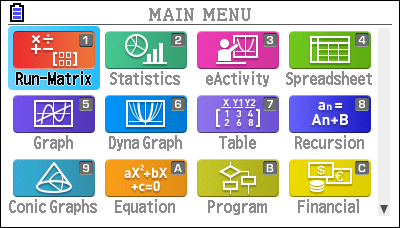
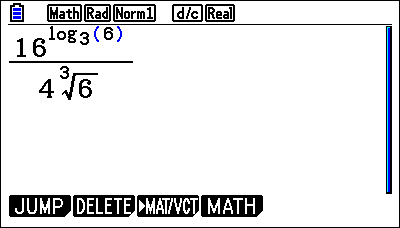
I am a casio calculator fan. I use the casio fx-115es plus for an applied math class. Its capabilities and the very modest price help our students. I particularly like the prime factorization app.
I recently obtained an fx-CG50, and I really like it, although I am surprised the prime factorization option does not seem to be available. Do you know of any available apps for it?
Hello Stephen,
I don’t know of any way to get the Casio prime factorization app on to the fx-CG50. However, after reading your comment I was able to make a program for the Casio fx-CG50 that finds all the prime factors of a number entered by the user. I will have a tutorial up on the programs page of mathclasscalculator.com within 12 hours.
Hello!
I am planning to buy a better calculator and even though I know that HP Prime is my best choice, I would like to know one thing: does de Casio CG-50 do Matrix Calculations with complex inputs?
Thanks!!
No, currently it will not do matrix calculations with complex numbers.
is the only reason the TI-84 Plus CE is pricier than the Casio FX-CG 50 is because of the battery difference? And which one would you recommend?
That is one of the reasons, but the main reason is because Texas Instruments has become the standard for the industry, and for some reason they are the ones people turn to whenever looking for a calculator. I don’t see any overarching advantage for either of these calculations so I would go with the one that costs the least (the Casio). Unless there’s a specific reason you feel like you need the TI-84 Plus CE, you shouldn’t spend the extra money.
Which is better?Casio FXCG50 or HP prime?
The HP Prime is defiantly the better and more capable calculator. They are not in the same price range though, so unless you need all the advanced features that the HP Prime has you don’t need to spend the extra money.
Is Casio FX-CG50 better than Casio FX 9860 GII?
I’m considering between two of these. The CG-50 got my score when I looked at the price. However, I don’t know if Casio FX9860 has more advanced features than CG50 except for the color screen which I don’t really need.
They essentially have the same operating system. If one was to be named the more advanced one, it would be the CG50 because of its 3D graphing capabilities and stronger processor.
Hi, so which one do you think is better for college?? The casio fx-cg50 or ti-84 plus CE graphing calculator?
They are both very similar in capabilities. The cg50 can do everything the ti-84 can do and vice versa. The main thing is that most people have to-84s so if it’s important for a class that you follow on exactly or if you want to have the same calculator as your peers the ti-84 is the best option. But if you want to save some money, go with the cg50.
Casio FX-CG50 much much better than Ti84 Plus CE because its 3D graphing, Python support capabilities, more Flash ROM (16MB vs 4MB) and stronger processor (58 Mhz vs 48 Mhz). With add-in (xCAS), now CG50’s CAS function (like CAS use by HP Prime). CAS on 7x $, CG50’s the best Graphics Calculator today.